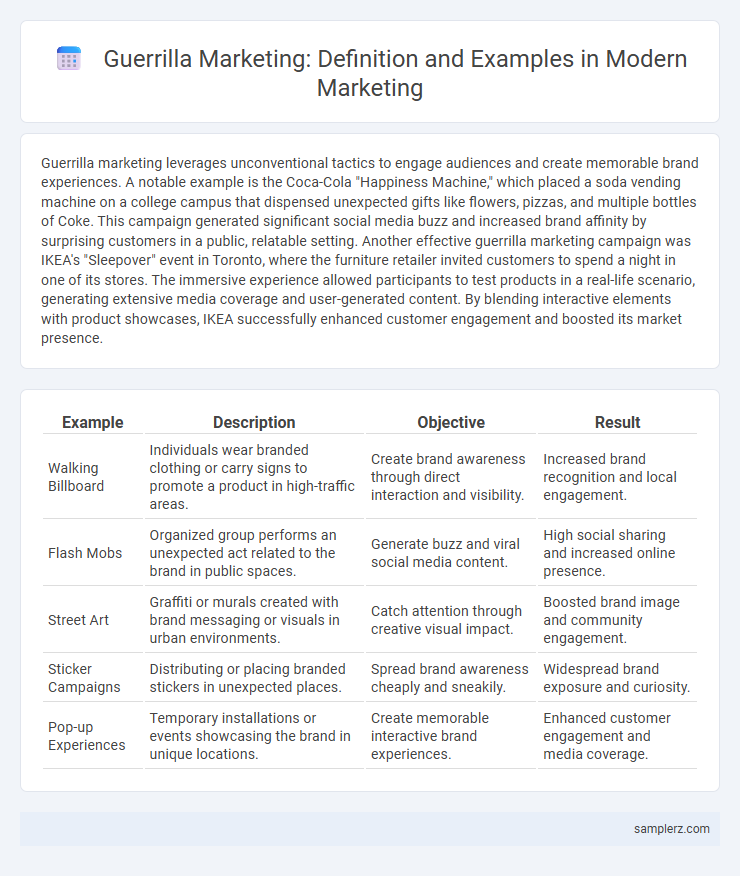Guerrilla marketing leverages unconventional tactics to engage audiences and create memorable brand experiences. A notable example is the Coca-Cola "Happiness Machine," which placed a soda vending machine on a college campus that dispensed unexpected gifts like flowers, pizzas, and multiple bottles of Coke. This campaign generated significant social media buzz and increased brand affinity by surprising customers in a public, relatable setting. Another effective guerrilla marketing campaign was IKEA's "Sleepover" event in Toronto, where the furniture retailer invited customers to spend a night in one of its stores. The immersive experience allowed participants to test products in a real-life scenario, generating extensive media coverage and user-generated content. By blending interactive elements with product showcases, IKEA successfully enhanced customer engagement and boosted its market presence.
Table of Comparison
| Example | Description | Objective | Result |
|---|---|---|---|
| Walking Billboard | Individuals wear branded clothing or carry signs to promote a product in high-traffic areas. | Create brand awareness through direct interaction and visibility. | Increased brand recognition and local engagement. |
| Flash Mobs | Organized group performs an unexpected act related to the brand in public spaces. | Generate buzz and viral social media content. | High social sharing and increased online presence. |
| Street Art | Graffiti or murals created with brand messaging or visuals in urban environments. | Catch attention through creative visual impact. | Boosted brand image and community engagement. |
| Sticker Campaigns | Distributing or placing branded stickers in unexpected places. | Spread brand awareness cheaply and sneakily. | Widespread brand exposure and curiosity. |
| Pop-up Experiences | Temporary installations or events showcasing the brand in unique locations. | Create memorable interactive brand experiences. | Enhanced customer engagement and media coverage. |
Unveiling Guerilla Marketing: Definition and Core Principles
Guerilla marketing leverages unconventional, low-cost tactics to create high-impact brand awareness and engagement, often through surprise or memorable experiences. Examples include flash mobs, street art campaigns, and viral social media challenges that captivate audiences by breaking through advertising clutter. Core principles emphasize creativity, originality, and deep audience understanding to maximize reach and emotional connection without large budgets.
Iconic Guerilla Marketing Campaigns That Made History
Nike's "Write the Future" campaign during the 2010 FIFA World Cup combined dramatic storytelling with global sports icons to create a memorable guerrilla marketing success. Coca-Cola's "Happiness Machine," a vending machine that unexpectedly dispensed free products and surprises, went viral for its innovative engagement and positive brand association. The "Fearless Girl" statue placed opposite the Wall Street Bull became a powerful symbol of gender diversity and strength, generating massive social media buzz and global recognition.
Creative Street Art: Turning Public Spaces into Brand Messages
Creative street art transforms urban environments into dynamic marketing canvases, engaging audiences through visually striking murals and installations that convey brand narratives. Brands like Coca-Cola and Nike have leveraged graffiti and stencil art to foster community connection and enhance recall by embedding their messages directly into daily public experiences. This guerrilla marketing approach amplifies brand visibility organically, driving word-of-mouth and social media sharing without traditional advertising costs.
Flash Mobs: Creating Viral Buzz on a Budget
Flash mobs serve as an innovative guerrilla marketing strategy, generating viral buzz with minimal budget by surprising and engaging audiences in public spaces. Brands leverage choreographed performances or spontaneous gatherings to create memorable, shareable moments that amplify social media reach organically. This tactic enhances brand visibility while fostering authentic consumer interaction and word-of-mouth promotion.
Ambush Marketing: Outshining Competitors in Unexpected Ways
Ambush marketing exploits high-profile events by associating a brand with the event without official sponsorship, effectively outshining competitors who bear the sponsorship costs. Examples like Nike's strategic presence during the 1996 Olympics, despite Adidas being the official sponsor, showcase how unexpected branding tactics generate massive consumer attention and buzz. This approach leverages surprise and creativity to maximize exposure while minimizing expenses, disrupting traditional advertising norms.
Interactive Installations: Engaging Audiences Beyond Traditional Ads
Interactive installations in guerrilla marketing create memorable brand experiences by encouraging audience participation through tactile, immersive setups in public spaces. Brands like Coca-Cola have deployed interactive vending machines that respond to user actions, boosting engagement and social sharing. These installations drive organic brand exposure and deepen consumer connection without relying on conventional advertising channels.
Social Media Stunts: Leveraging Online Virality for Maximum Impact
Social media stunts in guerilla marketing capitalize on viral content to generate buzz and extensive reach at minimal cost. Campaigns like ALS Ice Bucket Challenge demonstrate how user participation and shareability boost brand visibility and engagement exponentially. Leveraging trending hashtags, interactive challenges, and provocative visuals accelerates online virality, creating a powerful, organic marketing surge.
Pop-Up Experiences: Temporary Encounters with Lasting Impressions
Pop-up experiences create immersive, temporary marketing events that captivate audiences and generate buzz in high-traffic locations. Brands like IKEA and Nike use pop-up stores to showcase products innovatively, drive engagement, and foster social media sharing. These fleeting encounters leave lasting impressions by combining interactive elements with exclusive offers, enhancing brand recall and customer loyalty.
Brand Mascots in Unusual Places: Surprising Consumer Moments
Brand mascots appearing in unexpected locations create memorable consumer interactions that boost brand recognition and engagement. For instance, a mascot unexpectedly visiting busy public transit stations or local events generates buzz and social media shares, amplifying brand visibility. These surprise encounters foster emotional connections, enhancing customer loyalty through playful and memorable experiences.
Lessons and Takeaways from Successful Guerilla Marketing Examples
Successful guerrilla marketing campaigns demonstrate the power of creativity and unconventional approaches to capture audience attention without large budgets. Brands like Coca-Cola and Red Bull have leveraged street art, flash mobs, and interactive installations to create memorable experiences that boost brand engagement and virality. Key takeaways include the importance of local relevance, emotional connection, and strategic surprise to maximize impact and word-of-mouth exposure.

example of guerilla in marketing Infographic
 samplerz.com
samplerz.com